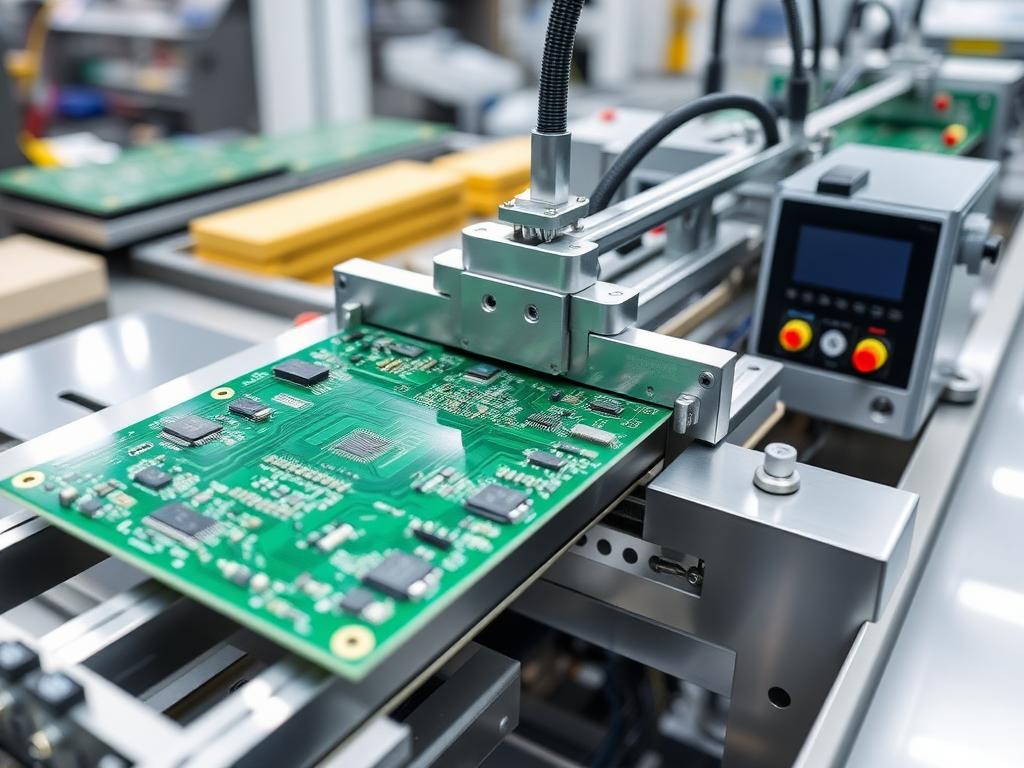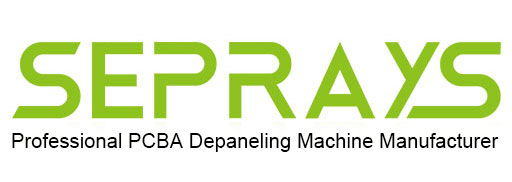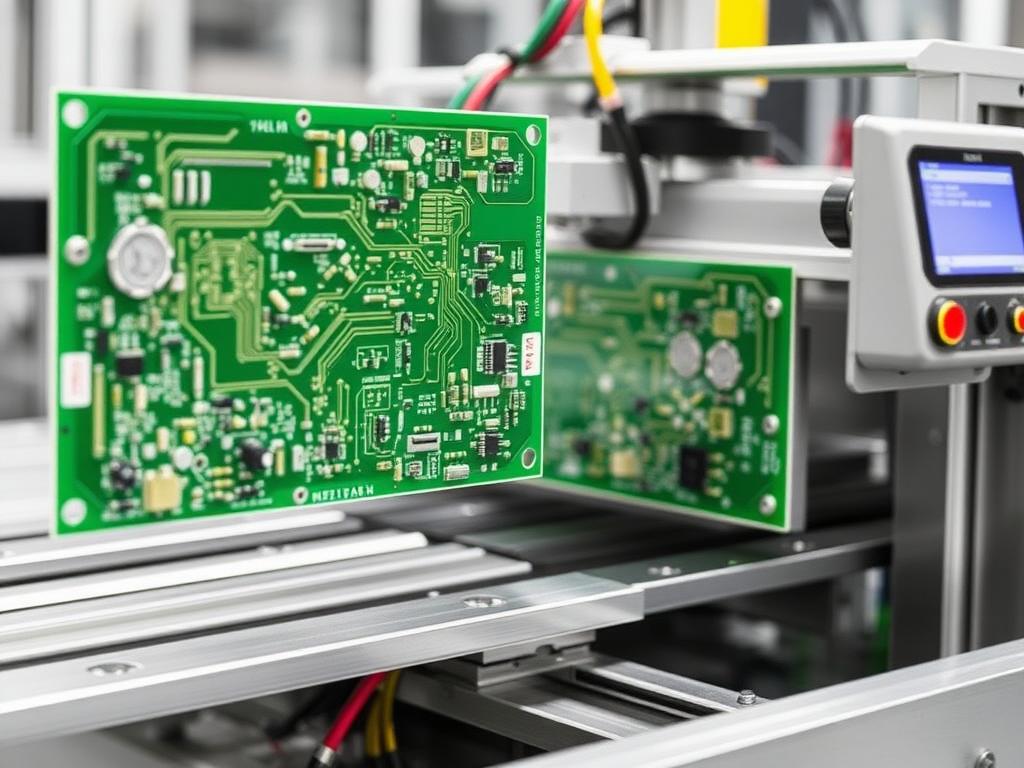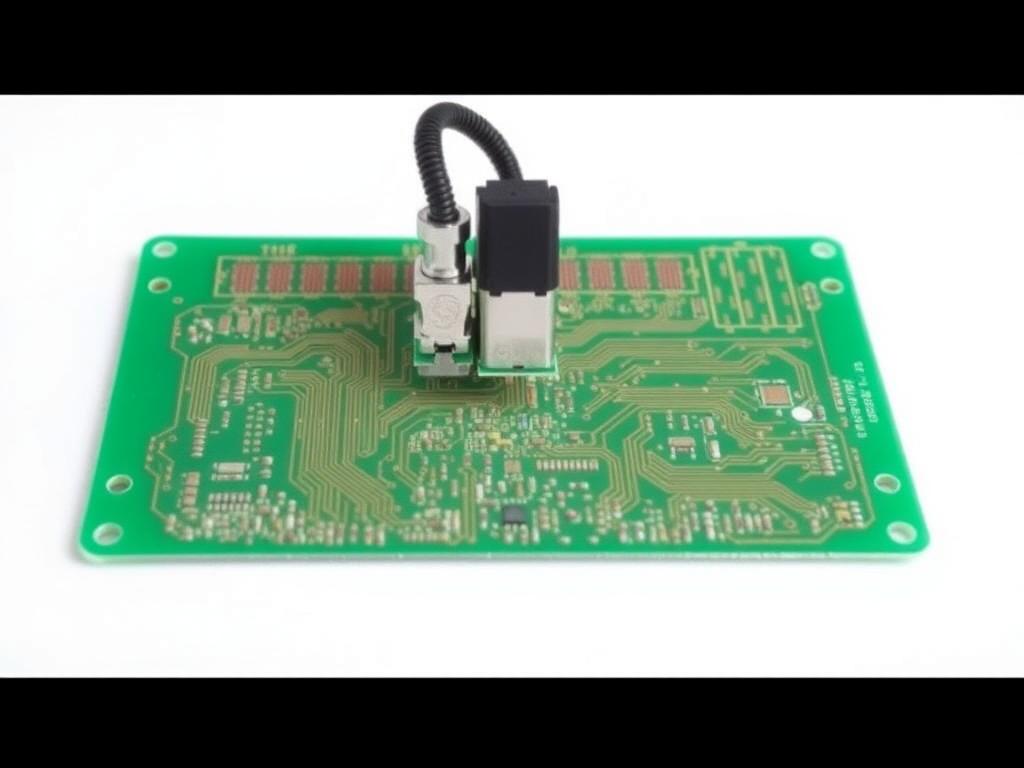![]()

PCB depaneling system for mass production
Precision PCB Depaneling: Choosing the Right Method for Your Production Line
As someone deeply embedded in the world of PCB manufacturing for the past two decades, I’ve witnessed firsthand the evolution of despainelização – the critical process of separating individual placas de circuito impresso de um maior painel. This article isn’t just another dry technical overview; it’s a journey through the various methods of PCB depaneling, sharing my practical experiences and insights to help you make the best choices for your processo de fabricação. We’ll explore everything from traditional roteamento to advanced despainelização a laser, ensuring you understand how to achieve optimal results for your specific needs. From TP-LINK to Foxconn, the world’s biggest electronics giants choose us – and I’m here to show you why.
The Crucial Role of Depaneling in PCB Production
Okay, let’s get down to it. The despainelização process, also sometimes called singulation, is essential. Once the placas de circuito impresso are populated with their electronic components, the large pcb panel is no longer needed, and the individual circuitos must be separated. But how is this done? Well, there are several métodos de despainelização available, each with their own advantages and disadvantages. The right choice of method isn’t just about separating boards; it’s about maintaining the integrity of the circuito and ensuring the efficient operation of your linha de produção. Do you know which despainelização approach best fits your production needs? This article aims to answer exactly that.
Understanding Your PCB Depaneling Needs
Before we dive into the specific métodos de despainelização, it’s critical to understand what factors influence your decision. Are you dealing with rigid pcbs ou flex pcbs? What is the height of the components? What type of pcb are you working with? Do you need despainelização em linha to increase production line speed or is an offline solution better for your workflow? The answers to these questions will significantly influence the type of máquinas de despainelização you should consider. Also, is cleanliness a critical concern? How about estresse mecânico? It’s all part of the equation.
What Are the Different Types of PCB Depaneling Methods?
There’s more than one way to separate PCB individuais. Each method has unique characteristics, and the right one depends on your requirements. What works for a small batch of simple boards won’t cut it for high-volume, complex assemblies. As we move on, we’ll cover each method in detail, including the pros, the cons, and the appropriate applications.
Mechanical Routing: The Workhorse of PCB Separation
Mechanical roteamento, using a roteador, is a widely used method that involves using a specialized cutting ferramenta to mill the PCB (placa de circuito impresso) material along a predefined path. This is suitable for various types of pcbs, offering good precision and versatility. However, it also has limitations with its speed and can leave behind some dust and debris. But it’s still a solid, custo-eficiente option for many fabricação de pcb operations.
V-Groove Depaneling: Efficient for Straight Lines
Ranhura em V depaneling, also known as pontuação v, utilizes a blade with a V-shaped profile to create a channel on both sides of the pcb panel, allowing the boards to be snapped apart. This is ideal for separating PCBs that are arranged in straight lines. It is efficient and simple, but is only suitable for panels that have straight edges and are designed to break easily along the v-groove.
Punching: High-Speed Separation, But Limited Scope
Soco is a fast method of pcb depaneling que usa um ferramenta ou mechanical dies para cortar o PCBs directly from the panel. It is a very fast way to separate, but requires the creation of a special fixture for each unique design, making it costly for low-volume production and not ideal for complex projetos de pcb com curvas e cantos agudos.
The Rise of Laser Depaneling: Precision Without Contact
Despainelização a laser is the cutting-edge tecnologia de despainelização. It uses a laser beam to cut through the PCB (placa de circuito impresso) material without physical contact. This process is exceptionally precise, generating a cut kerf width de less than 20 microns, making it ideal for separating smaller and more complex boards, as well as flex pcbs e componentes sensíveis.
What are the Advantages of Laser Cutting in PCB Separation?
Corte a laser isn’t just about fancy technology; it offers real benefits. One key advantage is the minimal estresse mecânico it imposes, leading to better board integrity. The laser can also easily handle complex shapes and fine details, and it’s ideal for cutting individual circuits with very narrow gaps. It’s become a critical tool for modern produção de pcb, and the technology continues to evolve.
How Does Automation Benefit My Depaneling Process?
Automation is now key in any modern fabricação de pcb process, and despainelização não é exceção. Automatizado máquinas de despainelização not only increase rendimento but also improve consistency and reduce human error. It is crucial to integrate automated sistemas de despainelização em seu linha de produção to maximize efficiency and keep up with the demand for PCBs. We offer a variety of automation solutions tailored to meet your specific requirements.
Choosing the Right Depaneling Method: A Practical Guide
So, how do you pick the right despainelização method? It isn’t a one-size-fits-all decision. It’s about understanding the design of a panel, the type of materials, production volumes, the required accuracy, and the budget. We provide a practical consultation to guide you every step of the way, ensuring that your processo de despainelização is as efficient and effective as possible. We understand the subtleties of projeto de pcb and the critical needs of the processo de fabricação.
My Experience and Expertise in PCB Depaneling Solutions
I’ve been in this business for over 20 years and have seen the production of printed circuit boards transform. I’ve also seen the rise of all types of pcbs and the increasing demand for smaller and more powerful componentes eletrônicos. My experience has taught me the importance of a well-optimized despainelização process. It’s not just about cutting the boards but also about maintaining quality and consistency, which are so crucial in montagem de pcb. I’m sharing my knowledge with you, so you can avoid common pitfalls and optimize your processo de fabricação.
Mechanical Routing Deep Dive
Let’s talk more about mechanical roteamento. This method uses a specialized roteador bit to mill away the material that connects the PCBs within the pcb panel. The speed of the roteamento is dependent on the material of the PCB (placa de circuito impresso), the thickness of the material, and the complexity of the path. The accuracy is also greatly impacted by the quality and type of bit being used.
Pros:
- Custo-efetivo: It’s a relatively affordable method, especially for larger, simple boards.
- Versátil: It works on various types of pcbs.
- Established Technology: Widely understood and implemented.
Cons:
- Dust and Debris: It can create dust, requiring cleanup and potentially affecting limpeza.
- Estresse mecânico: The cutting action can induce some estresse mecânico, which can damage componentes sensíveis.
- Velocidade: Slower compared to some of the more advanced methods.
I’ve seen roteamento work wonders in high volume setups that have lots of boards of a similar shape and size. The roteador head is moved using computer controls and very little operator interaction is needed. This makes it very repeatable and reliable.
V-Groove Depaneling: Simplicity and Speed
Ranhura em V depaneling stands out for its simplicity. A V-shaped groove or pontuação v is cut into the panel along the separation lines, and the PCB individuais are then broken apart. This process is ideal for panels designed with straight lines of separation between the individual circuits.
Pros:
- Velocidade: It is a very fast separation process.
- Low Cost: It is an economical method for designs suited for it.
- Simple: It is an easy method to learn and implement.
Cons:
- Design Limitations: Only works with straight-line separations.
- Potential for Rough Edges: Can create rough edges which sometimes require additional cleanup.
- Estresse mecânico: Breaking the panels can cause stress which can affect the integrity of the solda and the connections.
I’ve witnessed Ranhura em V depaneling excel in environments where there are individual printed circuit boards arranged in a grid format. The straight lines and high-speed separation process is a match for alto rendimento lines. However, when the designs get more complex, this solution is not a match.
PCB Punching: Speed at the Cost of Flexibility
Soco is another mechanical method that is used to cut the PCB individuais from the larger panel. Soco requires the creation of a die, which is created for each unique PCB (placa de circuito impresso) shape. This process is fast but the requirement for the die is very limiting.
Pros:
- High Speed: Very fast separation for large panels.
- Cortes limpos: When implemented correctly, the process can create very clean cuts.
- Repeatable: Very consistent across large runs.
Cons:
- Limited Designs: Not suitable for projetos de pcb with curves and fine features.
- Costly Tooling: Creating the custom ferramenta e fixação is expensive and not good for small runs.
- Estresse mecânico: The punching process can create a lot of estresse mecânico to the components on the edge of the board.
I’ve seen this type of method used when the designs are relatively simple and the production numbers are very large. For instance, if there are just a handful of parts on the PCB (placa de circuito impresso), then the soco process can make a lot of sense. It’s a good solution for simple shapes but it quickly becomes unsuitable if the shapes are more complex.
Depanelização a laser: o futuro da precisão
Despainelização a laser is the most modern processo de separação and is accomplished by using a focused laser beam. The laser beam is used to remove the PCB (placa de circuito impresso) material. The non-contact nature of this process, makes it ideal for sensitive materials and complex shapes. The non-contact nature of the cut also reduces the amount of estresse mecânico.
Pros:
- Precisão: It offers incredibly precise cuts, ideal for small or complex designs.
- Estresse mínimo: Non-contact cutting reduces estresse mecânico.
- Flexibilidade: Can handle curves, sharp corners, and a wide range of materials.
Cons:
- Custo: High initial investment but lower recurring cost in some cases
- Velocidade: It can be slower when compared to some of the other processes but this can depend on a few factors.
- Setup: It can take some time to configure, especially when a lot of different shapes or types of pcbs are being created on the same line.
I’ve seen despainelização a laser implemented in a lot of fabricação de pcb environments that create flex pcbs and also smaller rigid pcbs. It’s truly one of the most exciting technologies in modern produção de pcb. It allows the creation of very complex designs and it is ideal for situations where estresse mecânico is a concern.
Automation: Boosting Efficiency and Precision
The incorporation of automation in the processo de despainelização significantly boosts efficiency and reduces human error. Automation can take the form of an despainelização em linha system that handles the processo de separação and passes the PCB individuais directly into the next stage of the linha de produção. There are also systems that simply collect the boards for removal at a later time.
Pros:
- Aumento da produtividade: Automated systems can increase production line speed and reduce costs.
- Consistência: Provides highly consistent results, with every board being processed identically.
- Redução de erros humanos: Automated processes eliminate mistakes caused by operator error.
Cons:
- Initial Investment: Automated solutions can be an expensive up-front investment, although they pay off in the long term.
- Complexity: Can be complex to set up and integrate into an existing line.
- Manutenção: Requires regular maintenance and skilled staff to keep the equipment in top condition.
I’ve witnessed how systems that increase production line speed can be a game-changer in fabricação de pcb plants. With the right automation, produção de pcb can not only be faster, it can also be more cost-effective and reliable.
Making the Right Choice: Key Considerations
The best despainelização method is not one-size-fits-all, and the decision must be made on a case-by-case basis. Here are some of the key considerations you should make:
- PCB Design Complexity: Simple designs, with straight lines, can benefit from Ranhura em V methods, while complex designs and flex pcbs require a laser.
- Volume de produção: Soco or highly automated despainelização em linha solutions can be ideal for large runs, but smaller runs may be more cost-effective with a roteador ou laser.
- Orçamento: Your budget will dictate the type of machine and the level of automation you can afford.
- Material Sensitivity: Despainelização a laser is the go-to solution when you have very componentes sensíveis.
- Throughput Needs: If high line speed and reduce costs is key, you need an automated system.
- Cleanliness: If the environment needs to be very clean, a laser may be the right way to go.
It’s important to note that the need for systems that increase production line speed will continue to rise, and as such, the need for reliable despainelização soluções irão also continue to rise.
Perguntas frequentes
- What is the difference between depaneling and singulation? Both terms refer to the same processo de separação o individual printed circuit boards from a larger pcb panel. Despainelização is most often used but singulação é also called it.
- How can I prevent estresse mecânico during depaneling? Use non-contact methods such as despainelização a laser or carefully designed mechanical setups with the right fixação to provide enough one part and supports for the PCB (placa de circuito impresso).
- What are the essential steps in choosing a sistema de despainelização? Consider your projeto de pcb, production volume, material sensitivity, required precision, and budget. A thorough assessment will help you choose the best method.
- Pode despainelização a laser handle different types of pcbs? Sim, despainelização a laser is versatile and can be used on rigid pcbs, flex pcbs, and boards with very componentes sensíveis. It is excellent for all types of pcbs.
- How often should máquinas de despainelização be serviced? Regular maintenance is important and should be done according to the manufacturer’s guidelines. This will ensure the highest level of reliability and precision.
Resumo: Principais conclusões
- Despainelização é um passo crítico em fabricação de pcb, where PCB individuais are separated from a painel maior.
- The best method depends on the design of the panel, material type, production volume, and budget.
- Mechanical roteamento is versatile and cost-effective, suitable for a wide variety of boards.
- Ranhura em V is fast and efficient for panels with straight-line separations, but has projeto limitations.
- Soco is ideal for very large runs of simple designs, but has high ferramenta costs and isn’t suitable for complex shapes.
- Despainelização a laser offers exceptional precision and minimal estresse mecânico and is a good way to go when the boards are more complex or if limpeza is a concern.
- Automation can increase production line speed and reduce errors significantly.
- Careful selection of a despainelização method is essential to maintain quality and consistency.
- Always consider the need for systems that will increase production line speed to meet the demands.
Ready to take your fabricação de pcb to the next level? Entre em contato conosco hoje for a consultation and let’s find the perfect despainelização solution for your needs. We pride ourselves on delivering top-tier depaneling machines that cater to the needs of giants in the electronics industry – and we’re here to bring that same expertise to you. Be sure to check out our Máquina roteadora PCB, Depanelamento com ranhura em V, Máquina de perfuração PCB/FPC, Equipamento Automático, Acessórios, e Equipamento de linha completa SMT solutions as well. Let’s work together to ensure your linha de produção is both efficient and effective. With us, you’re not just buying machines, you’re investing in quality and expertise.




